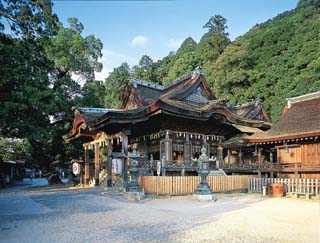Kids Web Japan
Web Japan > Kids Web Japan > Meet the Kids > Zenrin > City
Meet the Kids
Zenrin Gakuen
Where is Tadotsu?

The Seto Ohashi Bridges link Honshu and Shikoku.
(Shikoku Tourism Promotion Committee)
Tadotsu is located in Kagawa Prefecture, which is linked to Japan's main island of Honshu via the Seto Ohashi Bridge. It faces the Seto Inland Sea and occupies the northeastern part of Shikoku. Several islands in the Seto Inland Sea, including Shodoshima, are part of Kagawa. To the south lie the Sanuki Mountains and to the north are the Sanuki Plains. With an area of only 1,876 square kilometers, Kagawa is the smallest prefecture in Japan. It is bordered on the east and south by Tokushima and on the west by Ehime.

The main shrine of Kotohiragu Shrine.
(Shikoku Tourism Promotion Committee)
One of the best-known places in Kagawa is the Kotohiragu Shrine (in the town of Kotohira), where the guardian deity of seafarers is enshrined. It is also famous for the stone stairs leading to the main hall, which contain 785 steps. It attracts visitors from all over Japan throughout the year but is especially crowded during the grand festival in October, which features an energetic parade of a portable shrine.

Sanuki udon (wheat-flour noodles), a Kagawa delicacy. (Takamatsu City)
Kagawa is also famous as the birthplace of Sanuki udon noodles. Many shops here still make their own noodles, which are firm and very tasty. While there are now shops serving Sanuki udon nationwide, the noodles in Kagawa boast a distinctive flavor.
Tadotsu is a 30-minute train ride from Takamatsu, Kagawa's prefectural capital. It has developed as a port city as well as a transport hub, since it was where Shikoku's first-ever railroad was built during the Meiji era (1868-1912). Many houses in Tadotsu still feature latticed doors, giving neighborhoods a traditional look and feel.
The city is home to the temple Doryuji, the seventy-seventh stop on the 88-temple pilgrimage route around Shikoku. The 88 temples are the places where the great Buddhist priest Kukai trained some 1,200 years ago seeking enlightenment. Visiting all 88 temples is believed to grant visitors new insights into life, and many people continue to make the pilgrimage today.